On the penultimate day of the 2022 World Cup in Qatar, Croatia and Morocco met in the match for third place at the Khalifa International Stadium. Both teams were defeated in the semi-finals and thus missed out on the grand final.
The Croatians were already convincing at the World Cup four years ago and were only stopped by France in the final. This year, too, the team around midfield strategist Modric had a run that only the Argentines, around Messi, managed to stop in the semi-final.
Morocco had already made history before today’s match by becoming the first team ever to reach a World Cup semi-final. The Lions of the Atlas eliminated numerous favoured teams on their way to the Top 4, only ending their run against France. In the end, they lost 0:2 against the Equipe Tricolore.
The two teams already met in the preliminary round. However, a possible outcome for today’s match cannot be deduced from this – the game ended 0:0. Thus, at the end of the small final, Croatia was able to celebrate third place with a 2-1 victory after 90 minutes.
In this tactical analysis article we will focus on the opportunities Croatia had in the build-up to the game against the defensive tactics of the Moroccans. We will also take a closer look at Croatia’s behaviour after losing the ball in the game. But first, we will start the analysis by introducing the two lineups.
Lineups
Zlatko Dalic set up his team in a 4-2-3-1 system, which became a 4-4-2 system in defence. Dominik Livakovic played in goal and Ivan Perisic, Josko Gvardiol, Josip Sutalo and Josip Stanisic from FC Bayern München formed the back four in front of him. Mateo Kovacic and captain Luka Modric were the two defensive midfielders and at the same time the control centre of Croatia. In front of them, Andrej Kramaric acted as a hanging point and Mislav Orsic and Lovro Majer started on the flanks. The only nominal striker was Marko Livaja.
Walid Regragui set up his team in a 4-3-3 system, which repeatedly became the now typical 4-1-4-1/ 4-5-1 in defence. Sevilla FC’s Bono played in goal and the back four in front of him was made up of Achraf Hakimi, Jawad El Yamiq, Achraf Dari and Yahia Attiyat Allah. Sofyan Amrabat, Bilal El Khannous and Abdelhamid Sabiri formed the three midfielders and Hakim Ziyech and Sofiane Boufal started on the flanks. The only nominal striker was again Youssef En-Nesyri.
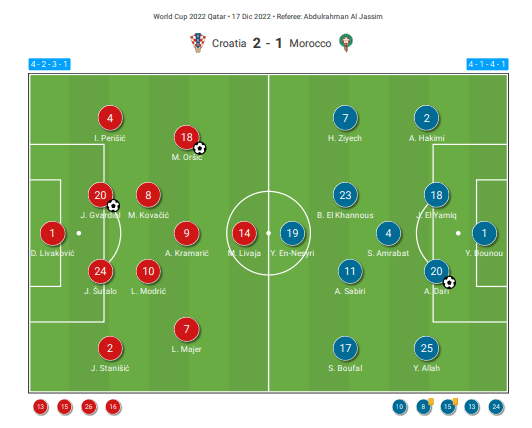
Croatia’s options with the ball
From the Moroccans’ recent games, Croatia could anticipate that they will often run against a well-organised defence. We will look at this defensive compactness in more detail in the next section. Now the focus will be on the options Croatia found against this defence.
Croatia had various options to get the game into the opponent’s third. The focus was mainly on overplaying the Moroccans’ compact midfield. In the following, we will now show three different ways Croatia tried to build up the game from the back.
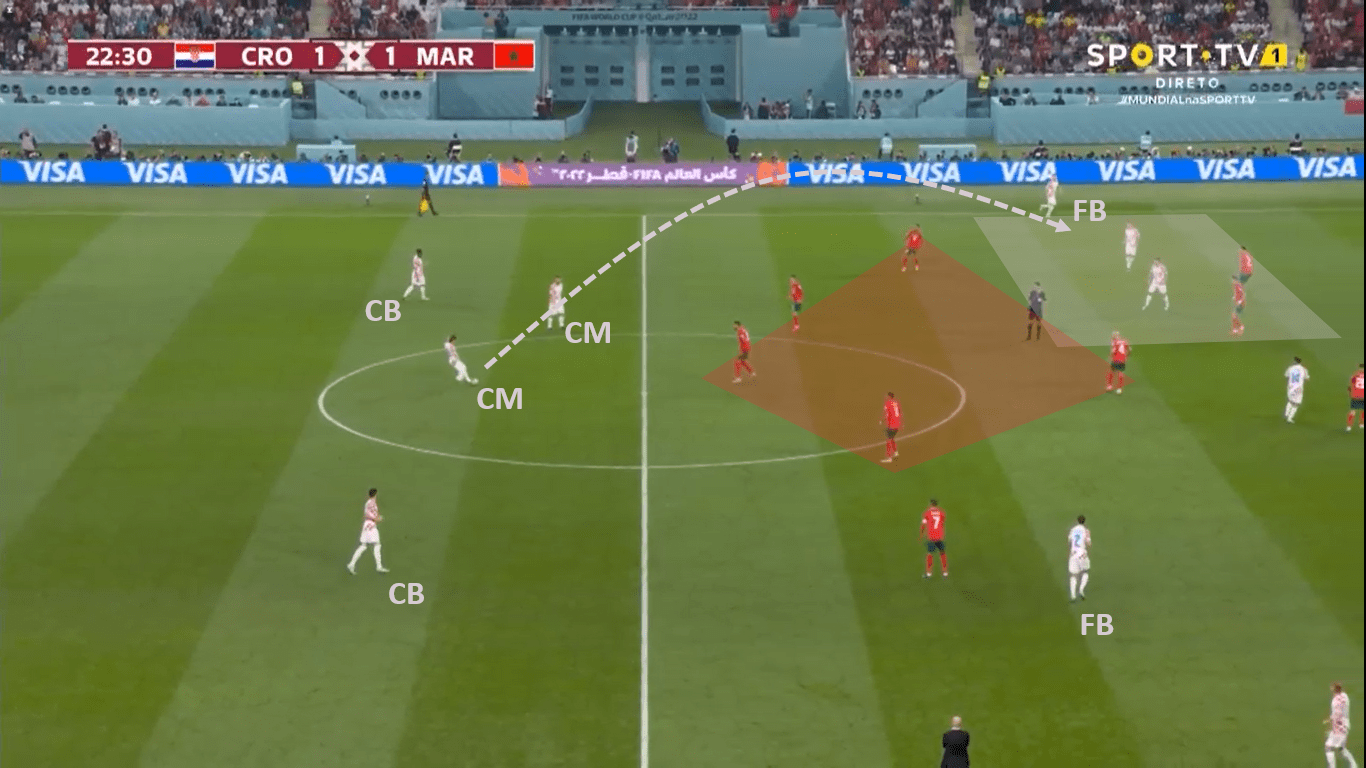
In this example, you can see the first variant that Croatia used to build up the game. In this picture you can clearly see how Croatia tries to overplay the Moroccans’ midfield. In doing so, they leave the entire centre of the midfield to the Moroccans.
You can see how both defensive midfielders of the Croatians drop deep to be able to set up the play. The rest of the Croatian defence consists only of the two centre-backs and the two midfielders.
In the centre of the pitch, it is easy to see how Morocco occupy the middle in absolute superiority. The Croats deliberately leave the centre to the Moroccans in order to take their strength out of the game.
The rest of the Croatian offensive players almost all push to the last line. You can see the deliberate superiority on the wing positions, as in this case on the left wing.
Since the Croatians have players in their own ranks with Modric and Kovacic who can play precise long balls to the outside and behind the chain, they try to use this means. In this way, they can overplay the midfield and at the same time reduce the chance that Morocco can switch over by mispassing in midfield.
This variation, with both central midfielders deep in their own build-up, was one of the different options the Croats tried to use.
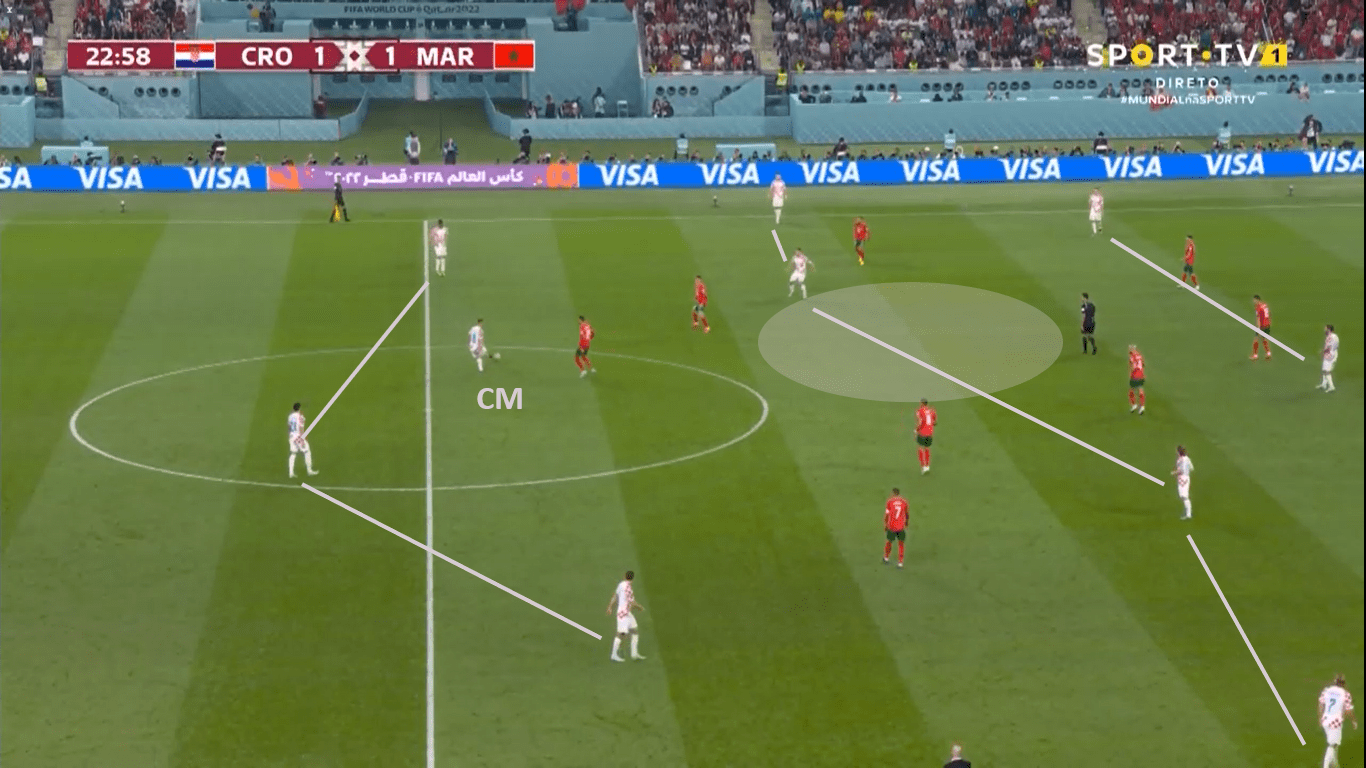
Here you can see another means by which Croatia tried to outplay the Moroccan midfield block. In doing so, they set up with an asymmetrical three-man chain. In front of it is one of the two defensive midfielders to pick up the ball.
Croatia set up in a 3-1-4-2 system here, and you can see that the ball is shifted to the left side, and at the same time they overload it in the front of their own system. With the rest of the defence with four players, they take a higher risk but can position more of their own players in the opponent’s half.
This three-man defence allows them to weaken the Moroccans’ run-up. They can shift the game more quickly and thus irritate or stop the run-up behaviour.
In this way, they can again overplay the midfield and still have enough players behind the first opposing line. This allows them to make good offensive actions by targeted passes behind this line. Nevertheless, there is the risk that Morocco can switch quickly in the event of misplaced passes. This will be discussed in more detail in the current article.
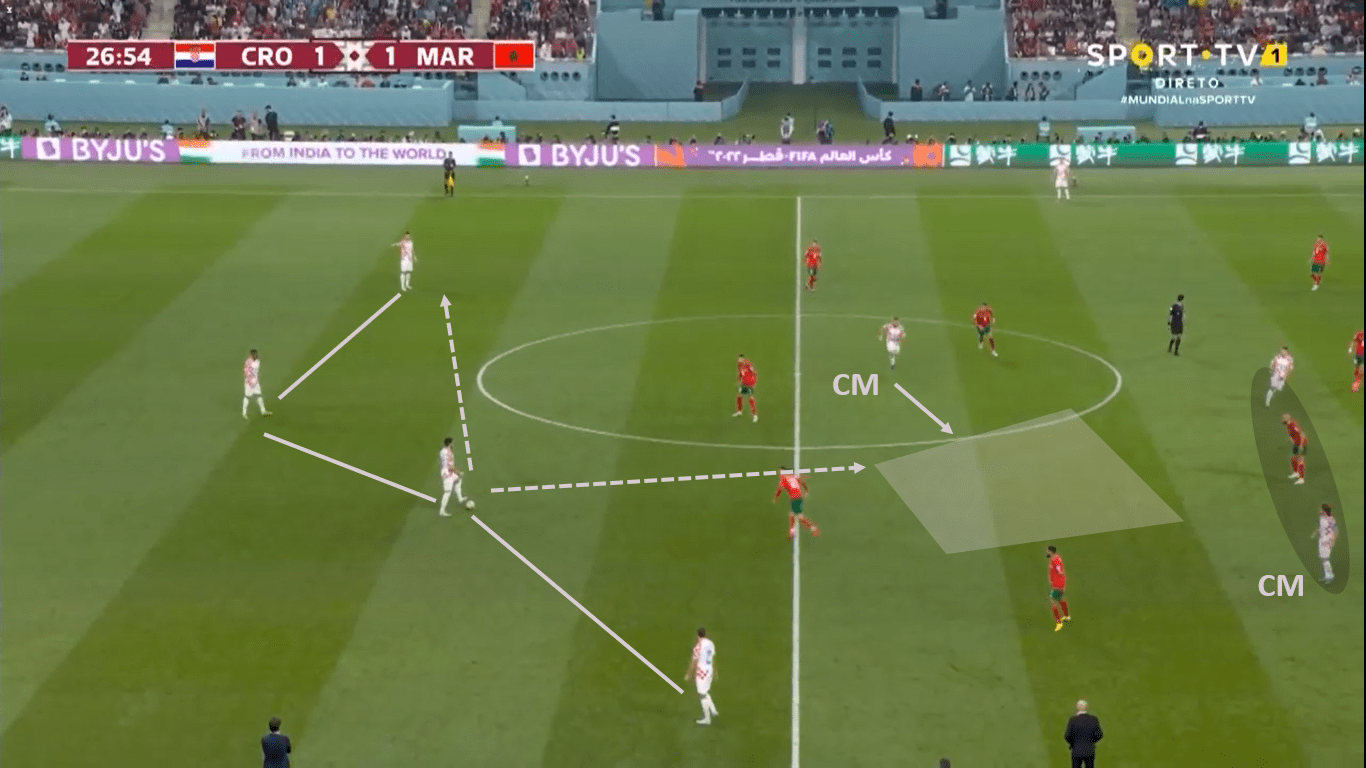
In the next example, in contrast to the previous one, Croatia does not set up with an asymmetrical four-man backline, but with a “classic” four-man backline. The midfielders move further up the pitch.
You can also see that Amrabat is tied up with two opponents in front of his own defence. In this example, Croatia once again leaves the entire midfield to Morocco.
The centre-back with the ball has two different options: Either he plays the ball to the incoming midfielder in order to be able to use the overloaded right side, or he shifts play to his own other side.
So you can see in all three examples how Croatia repeatedly tries to overplay the Moroccans’ strong midfield in different ways. In doing so, the options sometimes brought more or less risks.
Morocco’s defensive performance
Morocco showed a solid defensive performance throughout the tournament. With the exception of the early stages against France in the semi-finals, they have always played in their 4-1-4-1 system. They have almost perfected this system and have made it difficult for every opponent so far, no matter how prominent they were.
Their goal so far has been to be able to mark the opponent’s playmaker in the centre with four of their own players. But by pulling their own playmakers deep into their own half, Croatia’s first line had little access to the game.
In the end, however, this was not so bad for the Moroccans, as they were still able to keep the spaces compact in their own half. In the following, the Moroccan defence is listed again. This is similar to the previous games.
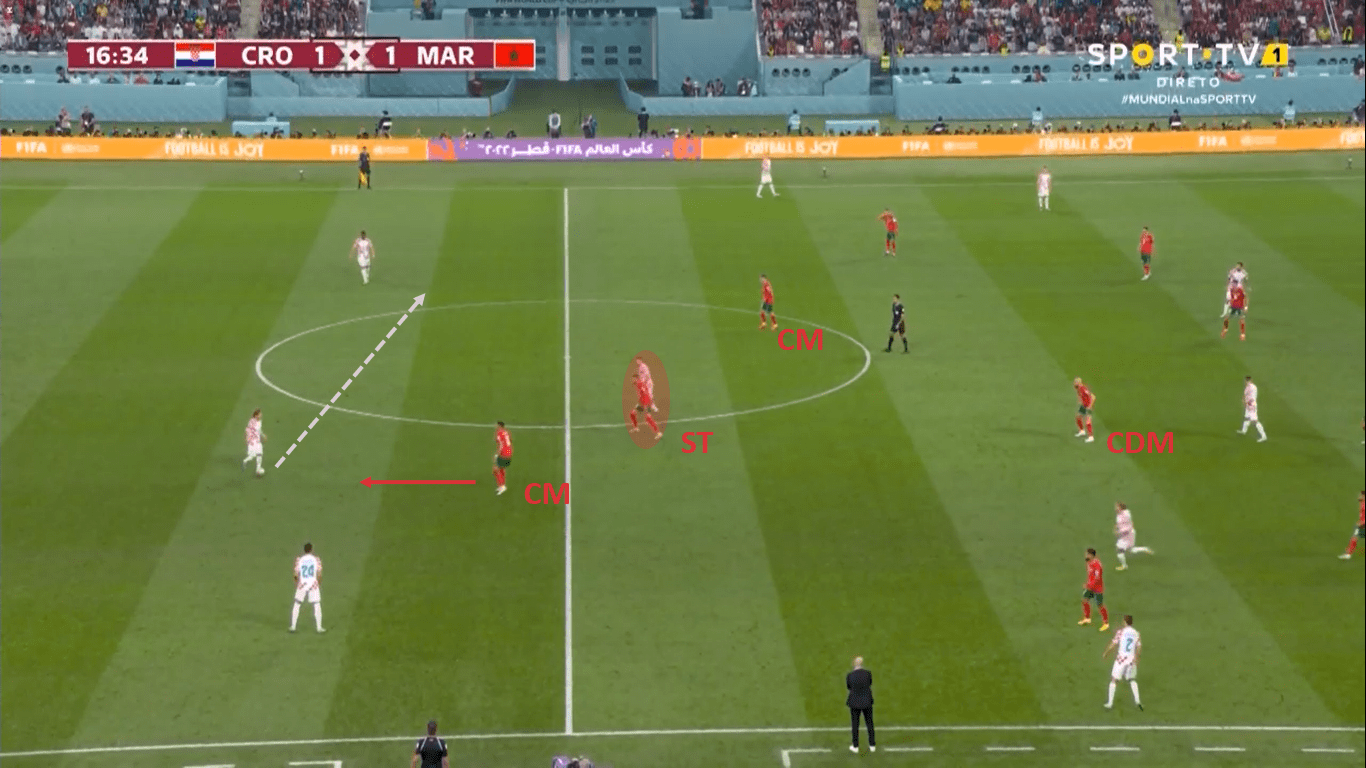
Here you can see how Croatia once again set up in their asymmetrical three-man backline. Even though Croatia do not deliberately place their build-up player in the centre, you can see how the Moroccan striker marks this one player in the centre anyway.
In this scene, the run-up to the opponent’s build-up line is followed by the central midfielder who takes on this task on that side. Through this run-up, they force the Croatians either to shift sides or to hit a long ball.
In this scene and in the entire game, Amrabat acts as a clearer in front of his own defence. He covers the spaces behind the midfield line and also in front of his own defence.
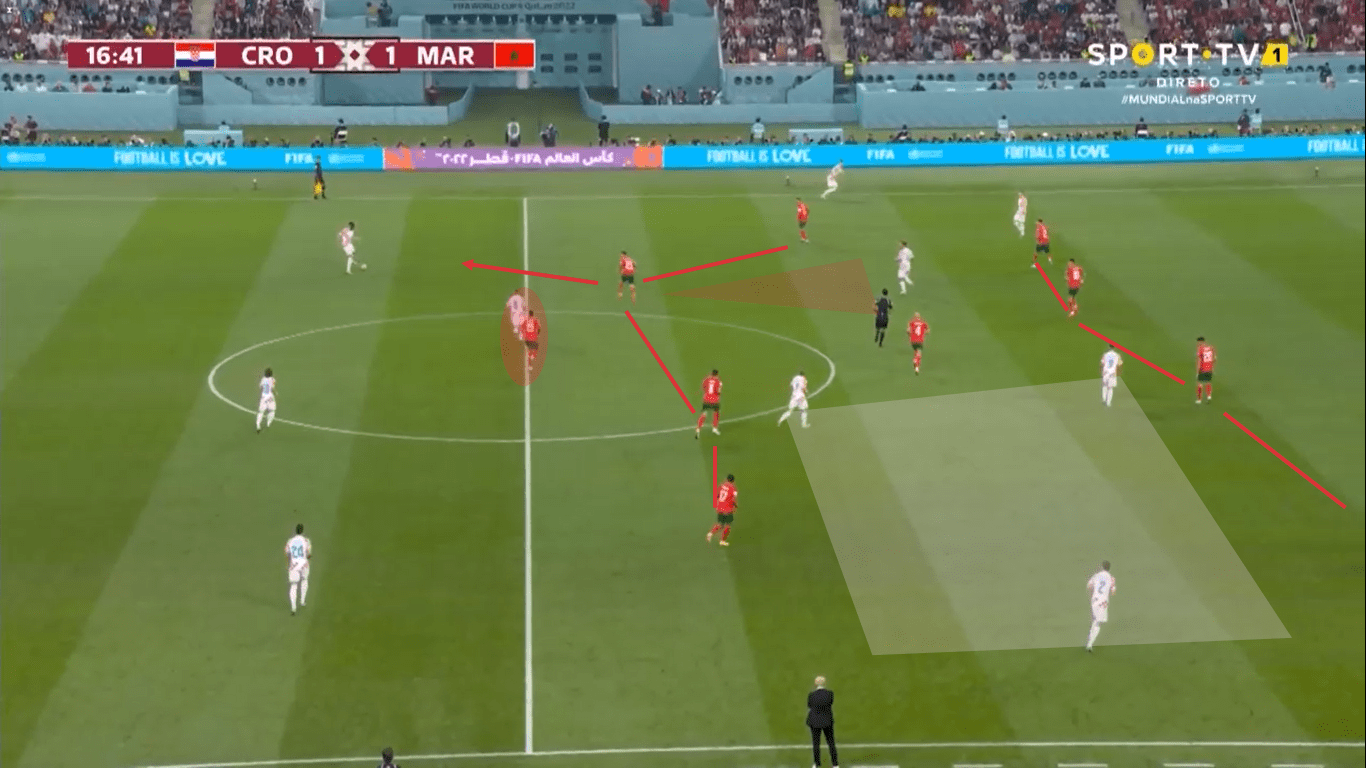
In the next picture, you can see the follow-up scene to the previous one. The Moroccan striker tries to mark the opposing central midfielder. The left central midfielder, who has just started to run, drops back into the midfield line.
In turn, the right central midfielder runs at the opposite centre-back in order to be able to direct him to the outside. In doing so, the right outer midfielder is already prepared for the ball, for the opposing full-back.
The Morocco right central midfielder continues to have the Croatian left back in his cover shadow as he runs at the left central defender. The right midfielder also marks him, but is already prepared to press the left defender.
This run-up behaviour could already be seen throughout the tournament. The starting midfielders from the centre can mark the opposing central players in the cover shadow during the run-up.
This enabled them to force not only Croatia but also other opponents to lose the ball in the centre time and again. In doing so, they deliberately left the far wing free in order to be able to generate superior numbers on the ball side.
In their 4-1-4-1 system, they had Amrabat as a defensive midfielder who could provide further security across the full width in front of the defence. If one of the two central midfielders ran at the opposing centre-back, he could also mark with his cover shadow.
If the opposing central midfielder moved out of the covering shadow, he could be run at by Amrabat. It was important for Morocco that he could not turn and was disturbed directly when he received the ball. This allowed the overplayed players to move up and strengthen the defence.
Morocco’s chances after winning the ball
Morocco tried again and again to switch quickly after winning the ball in midfield. Due to the nominal superiority in the centre, they were in a good position to start a counterattack.
The fact that Croatia sometimes took more or less risks in their different variations created spaces into which the switching Moroccans could have started.
Nevertheless, they were not able to implement their switching game as well as before because, as already mentioned, Croatia often tried to overplay the midfield. However, when the ball was played flat through the centre, it could be dangerous for Croatia.
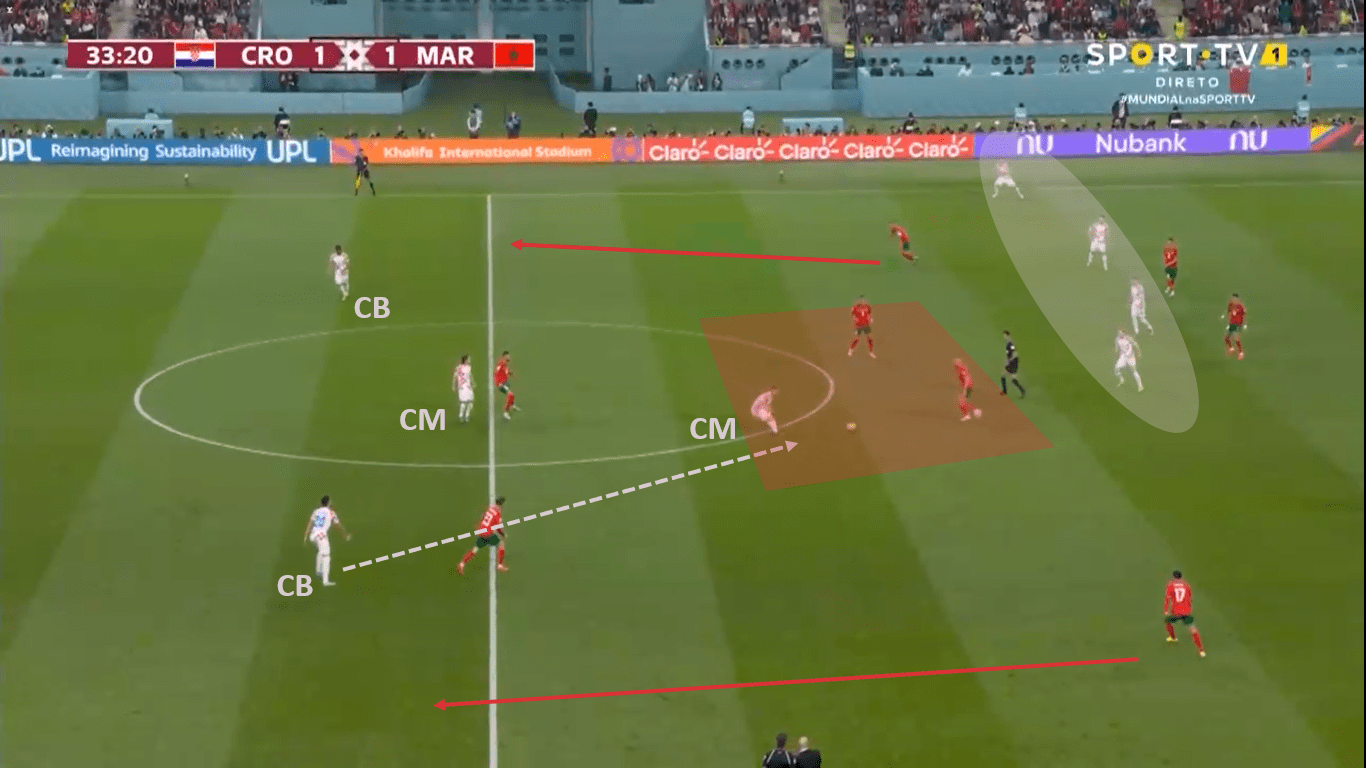
Here you can see in this picture how Croatia in the build-up play tries to play over the Moroccan first line by playing a flat ball in the centre. The rest of the defence consists of only three or four players.
This misplaced ball in the centre creates a good switching situation for the Moroccans. Both wingers quickly realise that such an offensive situation presents itself for them.
Both start directly forward on the outside to make the game as wide as possible. Nevertheless, the focus is on winning the ball in the centre. They try to secure the ball by having more players in the played zone.
If you overplay the central player you can create a 5vs3 situation by skilful attacking. By having your own striker tie up the opposing central midfielder in front of the chain, the latter is also tied up in the backward movement and defence at the same time.
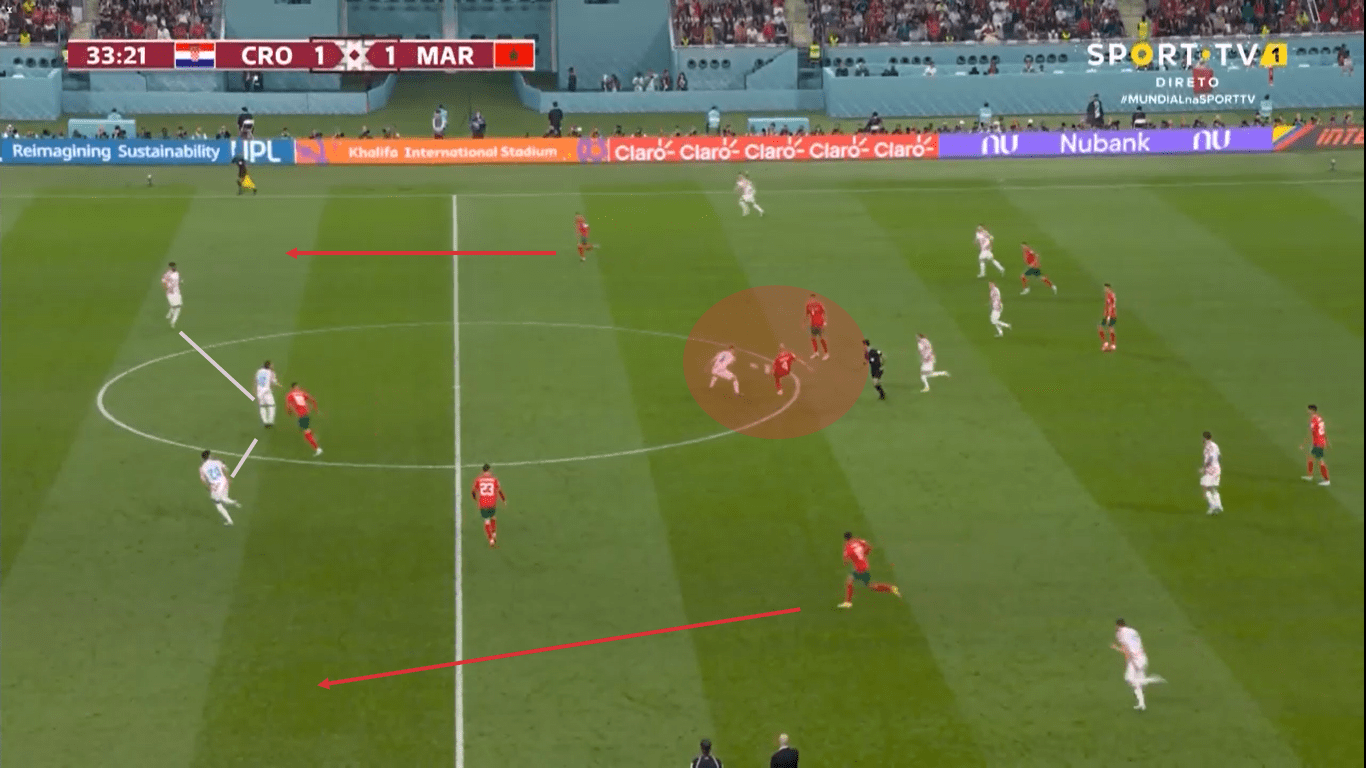
In the next picture you can see Morocco trying to switch as a result of the first scene. Here you can see, as already mentioned, that both outside midfielders start shortly after winning the ball.
Together with the forward in the middle, they try to keep the outer lanes free for the starting players. Nevertheless, the focus is first on securing the ball.
Even if this situation did not result in a goal chance, Morocco tried, as they had done throughout the tournament, to pose these problems to their opponents and thus become dangerous themselves.
Conclusion
Finally, we will summarise the most important tactical points that have just been analysed:
Croatia were overall well adjusted to the opponents’ defence and knew what was coming. They had different options to overplay the opponent’s midfield and not give them access to the game.
Morocco nevertheless managed to convince again with their strong performance in the basic defensive order. They once again posed problems for a good opponent with their compact defence.
In the end, all three goals came from standard situations. The game itself was largely determined by the two defensive lines. However, Croatia and Morocco have been known to focus on the defensive in the game.
Already in the first half, Croatia was able to take a 2-1 lead after a rehearsed free-kick and another goal from a standard and thus celebrate their third place at the 2022 World Cup in Qatar after the runner-up title.





Comments